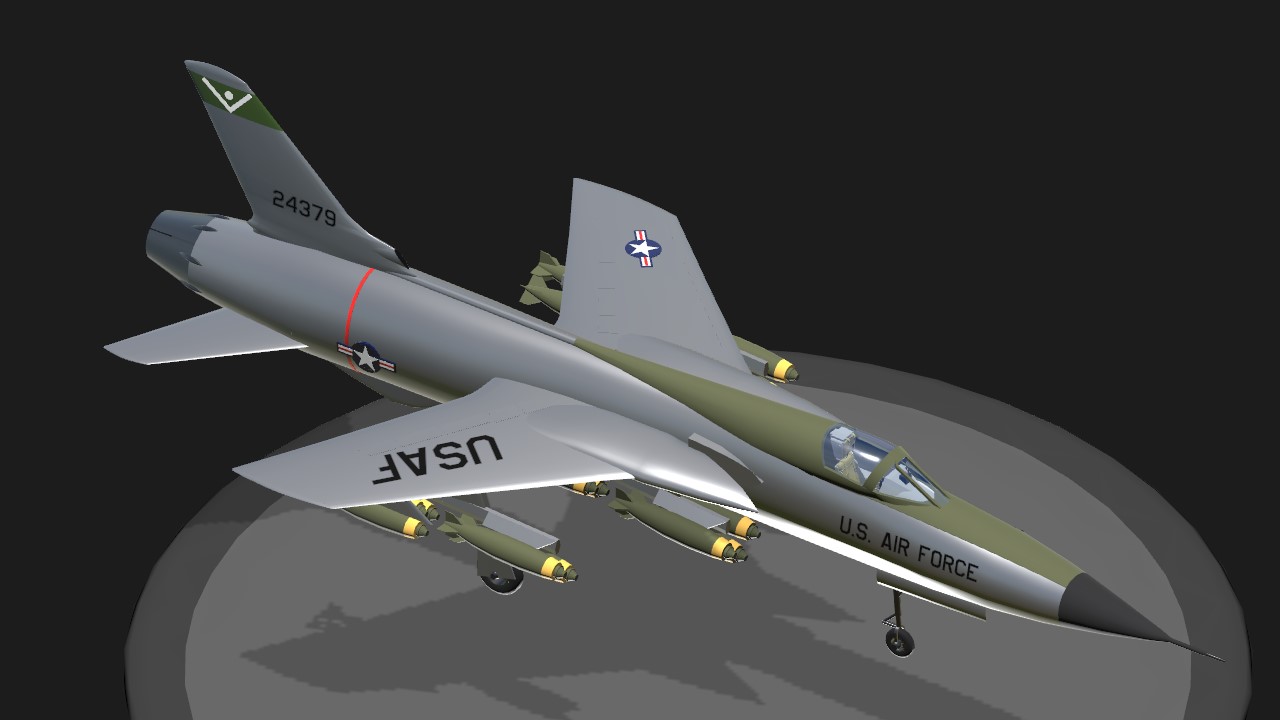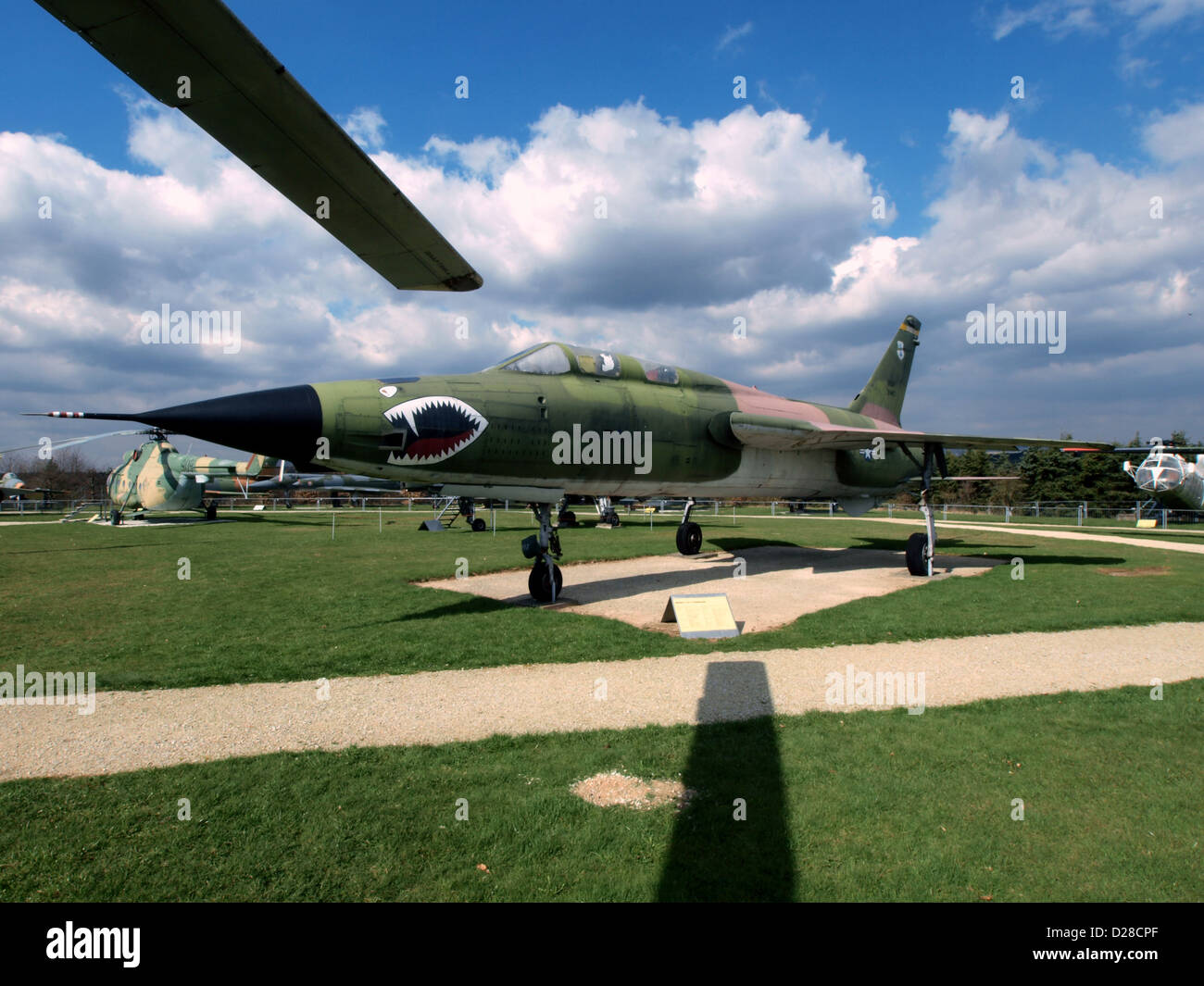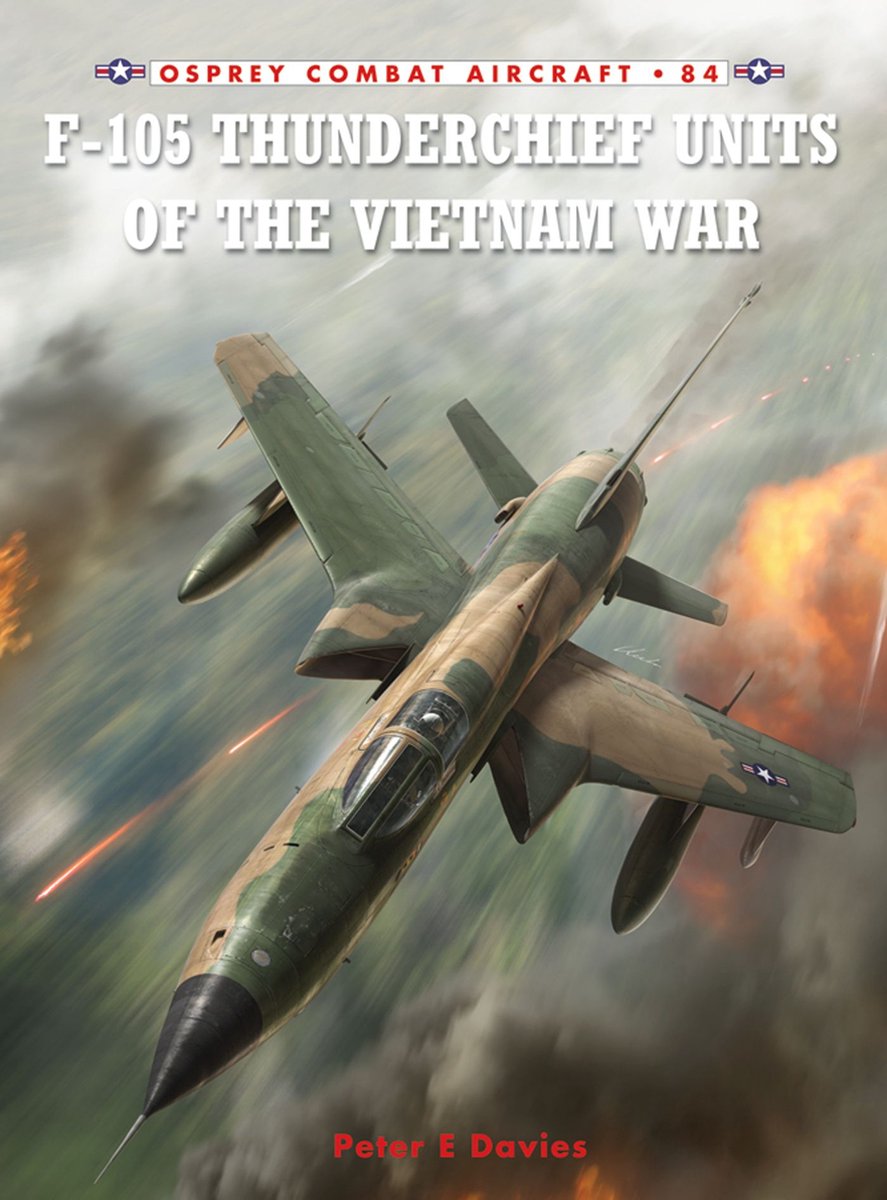Thunderchief Aircraft - The Republic F-105 Thunder Chief was an American supersonic fighter-bomber that served with the United States Air Force from 1958 to 1984. Mach 2 capable, it conducted most of the strike bombing missions in the early years of the Vietnam War; It was the only American aircraft to be removed from combat due to high loss rates.
It was originally designed as a single-seat, nuclear-attack aircraft; A two-seat Wild Weasel version was later developed for the Special Suppression of Surface-to-Air Defenses (SEAD) role. The F-105 is often called "Thud" by its crew.
Thunderchief Aircraft

After the North American F-100 Super Saber, capable of Mach 1, the F-105 was armed with missiles and a three-cannon; However, its design was tailored for high-speed low-altitude penetration of carrying a nuclear warhead inside. First flown in 1955, the Thunderchief entered service in 1958. The F-105 could deliver a larger bomb load than some American heavy bombers of World War II, such as the Boeing B-17 Flying Fortress and the combined B-24 Liberator. The F-105 was one of the premier attack aircraft of the Vietnam War; Over 20,000 Thunderchief sorties were flown, with 382 aircraft lost including 62 operational (non-combat) losses (out of 833 produced). Although less active than the smaller MiG fighters, USAF F-105s claimed 27.5 kills.
F 105d Thunderchief Aircraft Are Refueled On Their Way To North Vietnam Targets By A Kc 135 Stratotanker Aircraft. The Thunderchiefs Are Being Used To Check The Flow Of North Vietnamese Supplies And Troops
During the war, the single-seat F-105D was the primary aircraft delivering high bomb loads against a variety of military targets. Meanwhile, the two-seat F-105F and F-105G Wild Weasel variants, the Soviet-built S-75 Dvina (NATO reporting name: SA-2 Guide) became the first dedicated SEAD platforms to combat surface-to-air missiles . Two Wild Weasel pilots were awarded the Medal of Honor for attacking air-to-air missile sites from North Vietnamese soil, the same day one shot down two MiG-17s. They were "first in, last out" for dangerous missions, surprising Amy air defenses while the strike planes completed their missions and left the area.
The Thunderchief served as the largest single-seat, single-engine fighter in history, weighing approximately 50,000 pounds (23,000 kg).
The F-105 can carry up to 14,000 lb (6,400 kg) of bombs and missiles. The Thunderchief was later replaced as a strike aircraft over North Vietnam by the McDonnell Douglas F-4 Phantom II and the swing-wing General Dynamics F-111 Aardvark. However, "Wild Weasel" variants of the F-105 remained in service until 1984.
Republic Aviation launched the Thunderchief as an internal project to replace the RF-84F Thunderflash, which originally used characteristic wing-root air intakes to accommodate cameras in the nose. The design team, led by Alexander Kartveli, studied 108 configurations before settling on a large single-gene AP-63FBX (Advanced Project 63 Fighter Bomber, Experimental), specifically the AP-63-31.
F 105 Thunderchief
The new aircraft is designed primarily for supersonic, low-altitude penetration and delivery of a single, locally carried nuclear warhead. Emphasis is placed on low-altitude speed and flight characteristics, range and payload. The aircraft is equipped with a large engine, and a relatively small wing with high wing loading for stable ride at low altitude, and low drag at supersonic speeds.
Originally, the United States Air Force awarded the Republic a contract for 199 aircraft in September 1952.
However, by March 1953, the USAF reduced the order to 37 fighter-bombers and nine tactical reconnaissance aircraft, citing the approach of the Korean War. When the F-105 mock-up was completed in October 1953, the aircraft had grown so large that the Allison J71 turbojet was dropped in favor of the more powerful Pratt & Whitney J75. Anticipating a sustained development of the Zine, the first flight was expected to use the smaller Pratt & Whitney J57. Around 1953, the tire program was canceled by the USAF due to many delays and uncertainties related to the aircraft. However, on 28 June 1954, the USAF officially ordered 15 F-105s (two IF-105AS, four IF-105BS, six F-105BS and three RF-105BS) under the weapons system designation VS-306A.

The YF-105A prototype first flew on October 22, 1955, followed by the second YF-105A on January 28, 1956.
Why Pilots Loved The F 105 'thud' Despite Its Vulnerability
Powered by a low-pod J57-P-25 engine with 15,000 lb-ft (67 kN) of flare thrust, the first prototype reached a speed of Mach 1.2 on its first flight. (The J75 is expected to increase to 24,500 lbf (109 kN) with the afterburner.)
Both aircraft featured conventional wing root air intakes and plate-sided fuselages typical of early jet aircraft; Republic considered prototypes that did not reflect the aircraft's true potential due to numerous pre-production modifications.
Aerodynamic problems with insufficient power and transonic drag, as well as Convair's experience with their F-102, led to a redesign of the fuselage to conform to the section rule, with a characteristic "creepy waist".
Combined with unique forward-swept air intakes with variable geometry that regulate airflow to the engine at supersonic speeds and the J75 engine, this redesign enabled the F-105B to reach Mach 2.15.
K, F 105 Thunderchief, Airplane, Fighter Airplane
An MA-8 fire control system, AN/APG-31 range radar, and a K-19 gun sight allowing toss bombs were integrated to carry out the nuclear mission.
Five variants of the F-105C trainer type were added to the procurement program in June 1956, canceled in 1957. The RF-105 reconnaissance variant was canceled in July 1956.
In June 1957, Republic Aviation requested that the F-105 be named the Thunderchief, continuing the company's line of Thunder-named aircraft: the P-47 Thunderbolt, F-84 Thunderjet, and F-84F Thunderstreak. The USAF officially announced the designation a month later.

To meet the Air Force's need for an all-weather attack, Republic proposed the F-105D variant in 1957. This version featured a larger nose and radome with the AN/ASG-19 Thunderstick bombardment/navigation system. The AN/ASG-19 is designed around the Autonetics R-14A radar, which operates air-to-air and air-to-ground, and the AN/APN-131 Doppler navigation radar. In the cockpit, the F-105D has vertical tape instrument displays for adverse weather operations. The TX-43 nuclear warhead capability was also added. RF-105 reconnaissance development was also restarted based on the current F-105D. The first T-Model took its maiden flight on June 9, 1959.
Republic F 105 Thunderchief / National Air And Space Museum Editorial Stock Photo
Plans to build more than 1,500 F-105Ds were scaled back, resulting in the decision by Defense Secretary Robert McNamara to equip Sev fighter wings with the type. In November 1961, production was cut in favor of the Air Force accepting the Navy's F-4 Phantom II.
The last 143 Thunderchiefs are of the two-seat F-105F trainer type. Based on the F-105D, this model is 31 inches (79 cm) longer, allowing for a rear cockpit; Otherwise, the aircraft has the same flight performance as the earlier F-105D.
The F-105 was designed for a short nuclear campaign, which led to shortcomings such as a poor hydraulic layout and non-self-sealing fuel tanks.
Subsequent upgrades improved the reliability and weapons capability of the existing F-105Ds. In response to the surface-to-air missile (SAM) threat in the skies above Vietnam, dozens of F-105Fs were converted into anti-radar "Wild Weasel" aircraft, culminating with the F-105G.
Republic F 105f Thunderchief 63 8301 Major Leo Thorsness Captain Harold Johnson 357th Tfs Dragons 355th Tfw U.s. Air Force Takhli Royal Thai Air Force Base 1967
The F-105 is a mid-wing monoplane with 45° swept wing and tail surfaces. The single-gen is fed through two intakes at the wing root, leaving the nose free to a radome with multiple radars.
Its fuselage accommodated 1,184 US it. gallons (4,480 L) of fuel and an internal bomb bay. bomb bay 15 ft 10 in (4.83 m) by 32 in (0.81 m) by 32 in (0.81 m); It was originally designed to carry a nuclear warhead but typically carried an additional 350 US warheads. it. gal (1,300 L) fuel tank.
It had four lower wings and a gatorline pylon; Two inboard wings and sternline pylons are capable of accepting 450 and 650 US gallons of fuel. it. gal (1,700 and 2,500 l) drop tanks. Two external dry stations are wired for missiles or shells.

An M61 Vulcan (initially designated T-171E3) 20 mm 6-barrel Gatling-style cannon is mounted on the left side of the nose. A short-range AIM-9 Sidewinder air-to-air missile can be carried on each of the outer wing pylons.
F 105d Thunderchief
The F-105 was primarily designed for low-level interception and its low-altitude speed was its greatest asset in dealing with Amy fighters such as the MiG-17/J-5s.
Based on combat experience, the F-105D was updated with a better ejection seat, additional armor, improved gun sights and electronic countermeasures (ECM) pods on the wing.
Former North American F-86 Cyber pilot, Jerry Noel Hoblitt, recalls that he remembered the first time he saw the size of the F-105; He couldn't reach the air-interm lip with a running jump. The F-105 had a spacious cockpit (especially after the introduction of "Tep" instruments); Advanced electronics are easy to learn and operate. Takeoffs and landings are often performed in the 230 mph (370 km/h) range. Spoilers provided good roll control at all speeds and unique four-piston air brakes (the afterburner operated slightly to allow for greater flow).
Aircraft appraisal online, free aircraft appraisal, aircraft appraisal services, aircraft appraisal cost, aircraft appraisal jobs, aircraft appraisal course, aircraft appraisal training, business appraisal, rolex appraisal, appraisal software, 409a appraisal, aircraft appraisal report
Post A Comment:
0 comments so far,add yours